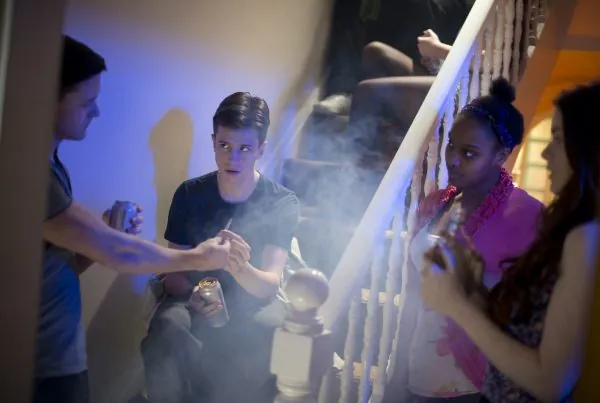Cannabis dabbing is an emerging trend that utilizes sticky resin or residue to create a stronger high. Cannabis dabbing enables teens to extract higher concentrations of THC from the same amount of cannabis than through conventional smoking. This can have long-term effects on teens and adults alike.
Dabbing refers to inhaling the smoke of a concentrated “dab” of cannabis oil or cannabis resin, which typically amounts to a much higher concentration of THC from the same plant or amount of dried cannabis. Dabs can be prepared alone or purchased from specialty shops, and usually have a sticky brown appearance, like sap or resin.
A dab is prepared through a variety of different methods, and each will have their own levels of THC concentration. Some cannabis enthusiasts design or sell devices built to extract a specific kind of residue from dried cannabis for dabbing. Others purchase dabs from stores that manufacture them from their own product.
Some of the methods of acquiring a cannabis dab can be dangerous, but the main health risk of dabbing is the inhalation of a much higher concentration of THC, or tetrahydrocannabinol. THC is the psychoactive component in cannabis, and it is what gives cannabis its characteristic high.
While THC cannot cause death by overdose, excessive amounts of THC consumption can trigger high levels of anxiety, or trigger a psychotic episode (as in, symptoms of psychosis, such as disorientation, dissociation, and hallucination). Higher concentrations of THC can also put users in danger if they try to drive or operate heavy machinery.
Dabbing is growing in popularity among young adults and teens. While recreational marijuana usage is selectively legalized in the United States, there are still health risks associated with long-term cannabis usage, and it is illegal for teens to purchase or use marijuana. Nevertheless, teens with access to the drug may use cannabis dabs rather than smoking the dried material itself.
How is Dabbing Performed?
There is no specific standard for isolating the resin or oil in cannabis, although multiple different methods have sprung up over recent years. Dabbing is an umbrella term that refers to the inhalation of most cannabis concentrates, usually through heating up the concentrate directly or indirectly, and inhaling the resulting vapors.
Cannabis concentrates can be prepared through water-based processing, dry processing, dry ice-based processing, and solvent-based processing. Solvent-based processing utilizes different chemicals, most commonly lighter fluid (butane), but also ether, alcohol, or propane. Some people use a nonflammable solvent, such as carbon dioxide.
Solvent-based preparation methods are popular because they are relatively simple to execute at home. They require the use of a tube, a solvent, and a filtering device. The dried cannabis is inserted in a tube and mixed with a solvent, and most of the solvent is removed through the filter to leave behind the residue once finished. The resulting residue is mostly free from the solvent because most volatile solvents evaporate completely over time, leaving only the concentrate behind.
Butane-prepared cannabis concentrate is also known as butane hash oil and has a variety of common names such as amber, black glass, wax, shatter, budder, or butane honey oil. Some of these names differ depending on the color and consistency of the resulting product – it can vary from runny, to waxy, to crystalline.
Once the cannabis concentrate is created or acquired, it can be lit and consumed in a variety of ways. Some involve using a blowtorch to heat water and create a vapor stream to heat the concentrate on a specialized dish. Others utilize heated metal, such as a nail or curling iron, to create a vapor. There are also electronic devices specifically designed for cannabis concentrates. Different temperatures create different kinds of vapor or smoke.
What Are the Long-Term Effects of Dabbing?
There are a number of concerns and risks associated with dabbing. The first and most severe risk is the risk of fire. While instructions for creating solvent-based dabs are available throughout the internet, improper handling of a solvent is a serious fire hazard.
There have been reports of multiple deaths due to improper preparation of a cannabis dab at home. Improper storage of cannabis for creating concentrates can also result in the inhalation or ingestion of dangerous microbes and fungi. Furthermore, improper dabbing can also involve solvent inhalation. Inhaling solvents can be dangerous for the brain and lungs.
Why High Levels of THC Are Dangerous
Aside from the risks of preparing cannabis concentrates, the consumption of cannabis dabs can also be harmful. Some teens are more susceptible to the risks of psychosis via high concentrations of THC and may not realize that consuming concentrated THC may trigger their symptoms.
There is also medical literature detailing acute and chronic lung impairment due to butane hash oil consumption, as well as damage to the heart.
Research also shows that repetitive consumption of high levels of THC can impair cognition and cause short-term memory loss. Teenage brains may be more susceptible to these risks, due to being in development. While rare, recurring cannabis usage can also lead to withdrawal symptoms, including anxiety, irritability, depression, tremors, loss of appetite, and abdominal pain.
Cannabis is generally seen as a safer drug than alcohol or other hard drugs. But dabbing enables people to consume far higher concentrations of THC than normal, whereas THC levels in cannabis products have already been increasing rapidly over the past two decades. Teens today have access to far more THC than previous generations, and these new methods can prove dangerous in both the short- and long-term.
If you or someone you know is frequently consuming concentrated cannabis, be sure that they understand the risks, especially if they are underage. Teens mistake cannabis as being risk-free, but it can result in both psychological and physical damage.
We at Visions help teens through our residential treatment programs. If your teen has been struggling to stop using cannabis, we can work with them to help them overcome their addiction. Give us a call today to find out more.








